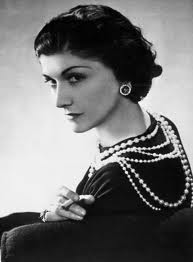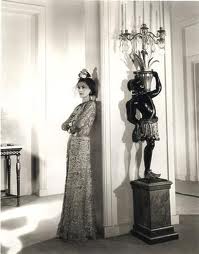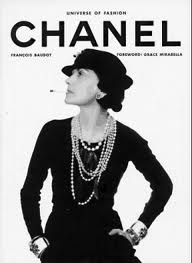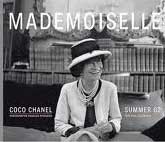Coco Chanel's legacy is so great that there is almost no need to introduce her. Every time you see a woman wearing monochrome, or oversized pearls or even trousers, Chanel is still sublimely, continuously referenced.
Fans from all over the world pilgrimage to her Paris appartement like it was a sacred shrine for one simple reason: it was and still is preserved as she left it.
Never before, and probably never again, will one woman influence so profoundly the face of style - as Coco Chanel said herself "Fashion fades, only style remains the same".

While Coco Chanel might have claimed she was born in Auvergne in 1893, she was actually born Gabrielle Bonheur Chanel in Samur in 1883.
When she rose became a celebrity later in life, Chanel reinvented her childhood, romanticizing it for the sake of her reputation. In fact she was born the oldest of five children, her father was a market stall holder and her mother laundrywoman, so her early years were anything but glamorous.
Coco Chanel's mother died when she was 12 years old and she was put into an orphanage by her father. She learned how to sew thanks to the nuns, which would one day earn her her living and much more. It has been suggested that the simplistic, monochrome attire of the nuns influenced her future designs.
When Chanel turned 18 she went to Moulins as an ambitious young woman determined to make her way in the world. She started performing in clubs which is how she earned the nickname "Coco". Some believe that the name came from one of the songs she used to sing while Chanel herself claimed that it was a shortened version of coquette, the French word for "kept woman".
Her career as a singer didn't take off or last very long, but by that time Chanel had become the mistress of a rich, young textiles heir Étienne Balsan. Her lover gave her all the trappings of a rich life: diamonds, luxurious and strings of pearl. The young girl from a poor background had no trouble adapting to her new lifestyle.

It was at that time that Chanel started designing, though at first it was no more than a hobby. After an epiphany in which she realized that designing was what she wanted to do with her life, Chanel left Balsan and went to live in his apartment in Paris. It is said that her nephew (supposedly her sister Julie's child) was actually hers and Balsan's.
While in Paris, Chanel met Balsan's friend Arthur "Boy" Capel who was even wealthier than her first lover.
Capel's affair with Chanel lasted 9 years and during that time he agreed to finance Chanel's first shops. Capel married a aristocratic English beauty in 1918 but the affair with Chanel still continued.
Tragically, the next year Capel was killed in a road accident and Chanel was devastated - for years afterwards she visited the road side memorial to place flowers there.
Chanel opened her first shop on Paris's Rue Cambon in 1910 and started selling hats. This store was soon joined by two others in Deauville and Biarritz and she introduced luxury casual clothes to the collection, fit for high society and wealthy ladies who wanted leisure and sport clothes.
Apparently her first taste of clothing success came from a jersey dress that she had made one day because it was cold in Deauville. People asked her where it was from and so her reputation started.
In the 1920s, Chanel's booming business got even more prominence. She introduced the now iconic Chanel suit. It had a fitted skirt that accentuated a woman's figure and a collarless jacket. It cutting edge and avant-garde for her time. Her designs borrowed from men's wear and scorned the popular fashions of the time in favor of comfort.
Long gone were the days of the corsets now that Chanel was here.
In 1925 Chanel launched her first perfume - called Chanel No.5, because it was the fifth sample product she created, it was also the first to feature the designer's name. It became Marilyn Monroe's favorite perfume and still today bottle is sold every 30 seconds.

Around the same time Chanel's little black dress became all the rage. The designer had taken a color that was associated with mourning and turned it into the chicest of evening wear.
As her star in the fashion world became brighter, so did Chanel's celebrity.
She began a long love affair with the Duke of Westminster when she met him on his yacht in 1923, however she refused his marriage proposal. When questioned about this she replied "There have been several Duchesses of Westminster — but there is only one Chanel".
In 1931 Chanel was introduced to the Hollywood giant Samuel Goldwyn through mutual friends and he offered the designer $1 million (about $75 million in today's money) to join him in California and design costumes for the MGM stars.
Chanel accepted but the deal didn't last for very long as the Hollywood starlets did not want to accept Chanel's help, so she returned to Paris.
Her company suffered greatly from the depression of the 30's, but it was World War II which forced Coco Chanel to close her business.

During the occupation of Paris, Chanel lived in the Ritz which also happened to be the preferred hotel of the upper echelons of the German military. Ever the opportunist, Chanel started an affair with an German officer named Hans Gunther von Dincklage who arranged for her to continue living in the hotel.
Widely criticized for this relationship, Chanel was interrogated after the war but not charged as a collaborator due to the intervention of the British royal family.
There can be no doubt that Chanel dealt closely with the Nazis during the war years and so she suffered in the court of public opinion some believing she had betrayed her country.
In 1945 Chanel left Paris, spending some years in Switzerland in a sort of self-imposed exile and did not return to France until 1954.
On her return to Paris, Chanel re-established her couture fashion house but the Parisians had not forgotten her dalliance with the Nazis and the collection was not a success.
However the British and the Americans seemed to be more forgiving when presented with pretty clothes and so she was applauded internationally. She spent many of the following years in the Hollywood that had once scorned her dressing stars such as Audrey Hepburn and Liz Taylor.
Coco Chanel died on January 10, 1971, at her apartment in the Hotel Ritz, having returned to triumphantly take the fashion world by storm at the age of 70. Her legacy continues to thrive and Karl Largerfield took over the reigns as head designer in the early 80s.
As Coco Chanel once said "In order to be irreplaceable one must always be different" and she followed her own precept to the letter.